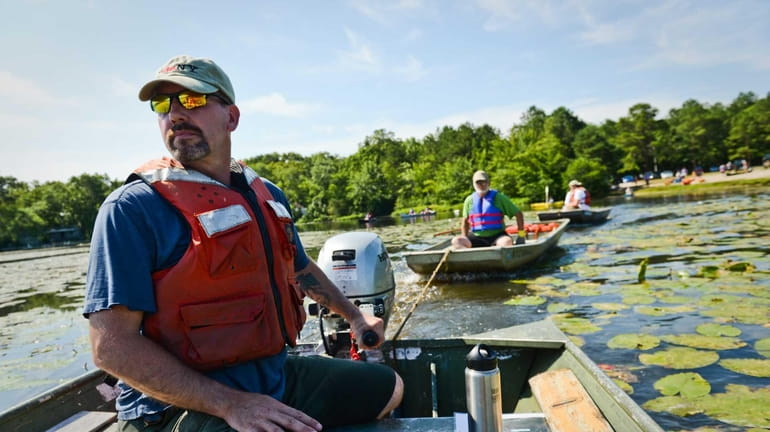Ridding Peconic waters of invasive weeds

Peter Davis, of Belport, and with the DEC, tows boats out into the water as volunteers and members of the DEC pull the invasive plant species out of the peconic waterway. (July 12, 2012) Credit: Steve Pfost
About 30 volunteers and Department of Environmental Conservation workers -- in kayaks, canoes and fishing boats -- combed the Peconic Lake and River Thursday for water primrose, an invasive aquatic weed threatening the watershed's ecosystem.
"This is something that's not just going to go away after a week," said Ernie Fugina, president of the Peconic Lake Estates Civic Organization. "Once it covers the lake, it will destroy everything beneath it."
Fishermen spotted the weed -- formally Ludwigia peploides -- in 2003, said Fugina, 70, of Calverton. Since 2006, Long Island conservation groups have worked with the DEC to fight the plant's advance.
The groups Freshwater Anglers of Long Island and Students Take Action for Tomorrow's Environment also donated boats and time Thursday, respectively. Such turnouts, Fugina said, have helped reduce water primrose to a fraction of what it was five years ago.
The perennial weed grows in thick mats dotted by yellow flowers. Its roots make it difficult for animals to move, Fugina said, and above-water leaves block the sun while adding little oxygen to the water.
Most alarming, Fugina said, is the plant's rate of reproduction. Water primrose can double its size in only 15 days to 20 days, according to the Peconic Estuary Program.
Charles Guthrie, regional fisheries manager for the DEC, said the plant's growth rate accelerates with heat. "We want to get ahead of it," he added.
It's still unclear how water primrose entered Long Island's waters, Guthrie said.
Though Thursday was the only planned harvest of the year, the DEC organized as many as four harvests annually until 2009. Since then, the amount of weeds removed yearly has decreased from 60 cubic yards to less than 10 cubic yards, Guthrie said.
Still, removal is a tall task since each weed must be pulled in entirety by hand, said Alison Branco, director of the Peconic Estuary Program.
"You can't use mechanical methods," said Branco, of Bay Shore. "When you break it apart . . . it spreads."
Added Fugina, "I don't want to see this lake destroyed."
